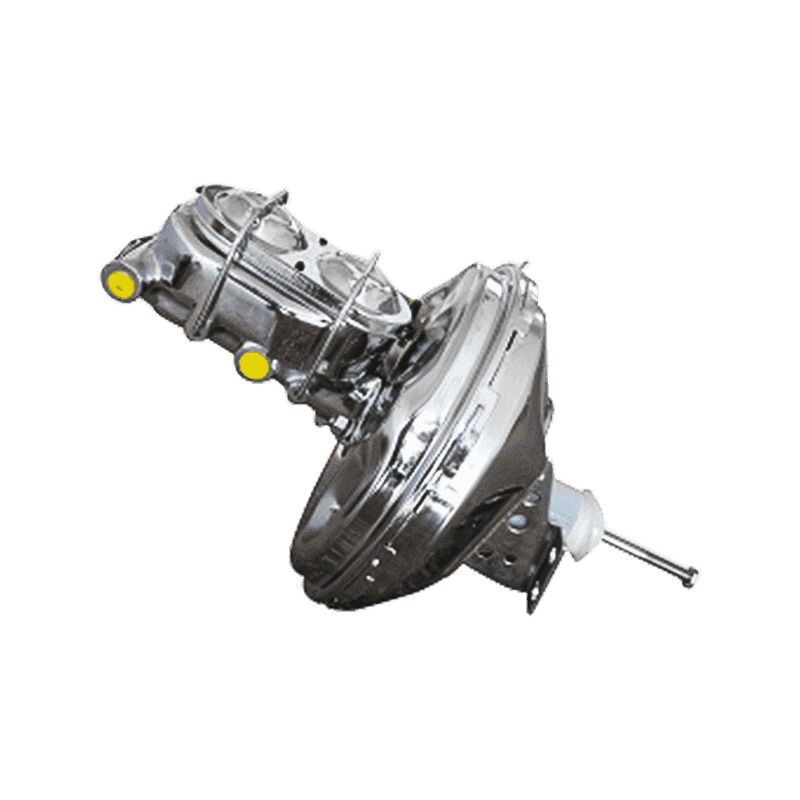 2025.10.11
2025.10.11
 Industry News
Industry News
Braking safety is one of the most important aspects of vehicle performance. A critical component in modern braking systems is the brake booster, sometimes referred to as a power brake booster. Its primary function is to reduce the physical effort required to apply the brakes while ensuring faster and more effective stopping power.
A brake booster is a device installed between the brake pedal and the master cylinder in a vehicle’s braking system. Its purpose is to amplify the force applied by the driver on the brake pedal before transmitting it to the hydraulic braking system. In essence, it allows drivers to achieve stronger braking with less pedal effort.
The brake booster operates using either vacuum or hydraulic pressure. Vacuum brake boosters utilize the pressure difference between the engine vacuum and atmospheric pressure to multiply pedal force. Hydraulic or hydro-boost systems, often found in vehicles with diesel engines or heavy-duty trucks, use hydraulic pressure from the power steering pump to achieve the same effect.
By increasing the force applied to the master cylinder, the brake booster ensures that the brakes respond quickly and efficiently. This is particularly important in emergency situations where milliseconds can make a difference in avoiding collisions.
The operation of a brake booster is straightforward in principle, though the mechanisms differ between vacuum and hydraulic types.
In a vacuum brake booster, a sealed chamber is divided into two parts by a flexible diaphragm. One side of the diaphragm is connected to the engine vacuum, while the other side is exposed to atmospheric pressure. When the brake pedal is pressed, a valve allows air into the chamber on the atmospheric side. This pressure difference pushes the diaphragm, which in turn amplifies the force applied to the master cylinder.
This process allows the driver to apply the brakes with much less physical effort while maintaining consistent braking performance. Without a brake booster, the same level of braking force would require significantly more pedal pressure, which can lead to fatigue during long drives or in stop-and-go traffic.
Hydraulic, or hydro-boost, systems operate differently. They rely on pressurized hydraulic fluid from the power steering system to assist braking. When the brake pedal is pressed, the hydraulic pressure pushes a piston that multiplies the pedal force transmitted to the master cylinder.
Hydraulic boosters are particularly effective in vehicles that require higher braking force, such as trucks or SUVs. They maintain consistent performance even when the engine is not producing sufficient vacuum, ensuring safety in all driving conditions.

Brake boosters improve safety in multiple ways. The first and most obvious is reducing stopping distance. By amplifying the force applied to the brakes, the booster ensures that the vehicle slows down or stops more quickly than it would with manual effort alone. This can be critical in avoiding accidents, particularly in emergency braking situations.
Secondly, brake boosters enhance pedal feel and control. A properly functioning booster provides a smooth and consistent resistance, allowing the driver to modulate braking with precision. This is important for maintaining control during sudden stops or on slippery surfaces, where abrupt braking can lead to skidding or loss of control.
Thirdly, brake boosters reduce driver fatigue. In city driving, where frequent braking is required, the physical effort needed to operate the brakes without a booster can be significant. The booster allows the driver to maintain safe braking without exerting excessive force, thereby reducing the risk of delayed reactions caused by fatigue.
Recognizing brake booster problems early is crucial for maintaining braking safety. Some common signs include:
Addressing these symptoms promptly is essential. Ignoring a failing brake booster can compromise braking safety and increase the risk of accidents.
Brake boosters require minimal maintenance, but regular inspection can prevent potential safety issues. Key areas to check include:
Regular vehicle inspections by a qualified technician can identify early signs of wear or malfunction, maintaining optimal braking safety.
Modern vehicles are designed with safety as a priority, and brake boosters play a significant role in achieving this goal. In combination with anti-lock braking systems (ABS) and electronic stability control, brake boosters ensure that braking is both powerful and controllable under a wide range of conditions.
By providing consistent braking assistance, boosters allow ABS systems to function more effectively. The booster ensures that sufficient force reaches the brakes during sudden stops, allowing ABS to modulate wheel lock-up without requiring excessive driver effort. This synergy enhances overall vehicle safety, particularly in adverse weather conditions such as rain or snow.
The brake booster is an essential component that significantly improves braking safety. By amplifying pedal force, it allows for quicker stops, reduces driver fatigue, and provides better control over braking. Both vacuum and hydraulic boosters achieve these goals through different mechanisms, but the outcome is the same: safer and more responsive braking.
Regular inspection and maintenance of the brake booster and related components are crucial to ensure that braking performance remains optimal. Recognizing early symptoms of failure and addressing them promptly can prevent accidents and maintain confidence behind the wheel.
In modern vehicles, brake boosters work in harmony with other safety systems, such as ABS and stability control, further enhancing overall driving safety. Understanding how this component functions and its importance can help drivers appreciate its role in everyday driving and emergency situations.
Investing in a well-maintained braking system, including a functional brake booster, is not just about convenience. It is a critical measure for protecting the driver, passengers, and others on the road.